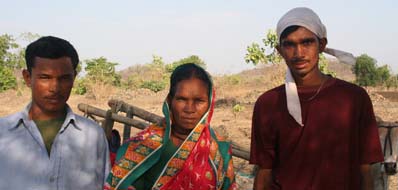India is playing an ever-important role in the world’s cotton market. Set to bypass the United States and become the world’s second largest producer of cotton in 2007, India has seen its cotton sector undergo critical changes in recent years. This handbook explores the various facets of cotton production in India — from the introduction of biotechnologies and the subsequent increase in production to the despair of small-scale cotton farmers — and analyzes the domestic and international forces at play. Cotton subsidies and agricultural policy are closely examined.
Major Crops
Seventy percent of India’s 1.1 billion people live off the land. Indian farmers predominantly grow rice, wheat, sorghum, millet, sugarcane, bananas, potatoes, maize, coconut, cotton and tea. Food crops make up the majority of the agricultural output. In 2006, sugarcane was India’s leading crop, accounting for 32 percent of its total agricultural output. Rice and wheat ranked second and third respectively. Cotton was the thirteenth most produced crop in India. Due to insufficient irrigation, India’s agricultural industry is heavily dependent on the monsoon. Seasonal winds blowing from the Indian Ocean and the Arabian Sea in the southwest bring heavy rainfall from June through September. Government policy and technological advances in seed and fertilizers are designed to reduce India’s dependence on the monsoon for a good or a bad harvest.
Cotton Farming in India
India boasts the world’s largest area of planted cotton and is expected to become the world’s second largest cotton producer in 2007. Cotton is predominantly grown in central India. Over half of India’s cotton production comes from the states of Gujarat, Maharashtra and Andhra Pradesh. Hoping to reverse the trend of declining yields and profitability, millions of Indian cotton farmers have adopted genetically modified, or transgenic, cotton seeds. These seeds, known as Bt cotton seeds, have allowed production to rise substantially, from 11 million bales in 2002-03 to 23 million bales in 2005-06.
Some Indian farmers have also taken to growing organic cotton because of the increasing demand for organic products in the West and its relatively low production costs. In 2006, India produced 31% of the world’s organic cotton.
The Green Revolution
During the 1960s, Indian farmers experienced several consecutive years of drought, which exacerbated India’s dependence on food imports. In response, the government made food security a priority and, in the 1970s, introduced a policy that enhanced the country’s agricultural sector, thus beginning India’s Green Revolution. The World Bank, the Rockefeller Foundation and the U.S. Agency for International Development helped develop high-yielding rice and wheat hybrid seeds, quickly nicknamed “miracle seeds.” Because the seeds were costly and required farmers to take on debt to buy them, the government put price support programs in place to help farmers manage the increased expense.The Indian government also subsidized modern farm machinery and promoted the use of chemical fertilizers. The Green Revolution spurred a sharp increase in food production from 72 million tons in 1965-66 to 152 million tons in 1983-84, and the new seeds eliminated the country’s dependence on food grain imports.
The benefits of the Green Revolution diminished during the late 1980s as chemical fertilizers deterioriated the quality of the soil. Farmers faced stagnating yields and were unable to pay off rising debts.
In 1991, the government confronted a severe financial crisis and responded with implementing economic reforms. The government progressively opened up India’s economy to foreign investments while seeking fiscal and monetary restraint. The trade regime was simplified to encourage imports of capital goods. However, the protection of the agricultural sector remained in place with high import tariffs, trade barriers and subsidies.
Indian Agriculture Today
Since 1994, India’s economy has grown at an average annual rate of 6.8 percent, reducing poverty by 10 percent. India’s booming economy has been fueled by growth in the industrial and service sectors. In contrast, the agricultural sector has been lagging behind, growing at a mere 2 percent in 2006. Moreover, the contribution of agriculture to the country’s gross domestic product (GDP) has also been declining steadily for the past thirty years. In 1970, the agricultural sector represented almost half of the Indian GDP; in 2006, the number sank to 20 percent.
Overall, the government is well aware of the dire situation in the rural areas. Drought, water scarcity, low crop prices, poor infrastructure, poor access to credit, and lack of rural employment plague rural India. In 2004, the ruling Bharatiya Janata Party (BJP) lost to the Congress party because BJP’s “India Shining” campaign was accused of neglecting the concerns of the rural population.
The current prime minister, Manmohan Singh, has made reforming the agricultural sector a priority and has called for “inclusive growth.” Also, concerns about the inability of India to produce enough food to feed its ever-increasing population have pushed the Indian government and Indian scientists to call for a second Green Revolution, and India has been at the forefront of the adoption of biotechnologies. However, progress in the agricultural sector still faces severe obstacles. Government attempts to improve irrigation in rural areas have been met with budget constraints and corruption among local officials. Subsidies meant to encourage farmers to dig wells, install drip irrigation and connect to the electrical grid have benefited only a small number of farmers and have failed to reach the neediest.
- Previous: Farmer Suicides in India
- Next: Cotton Subsidies and the World...



